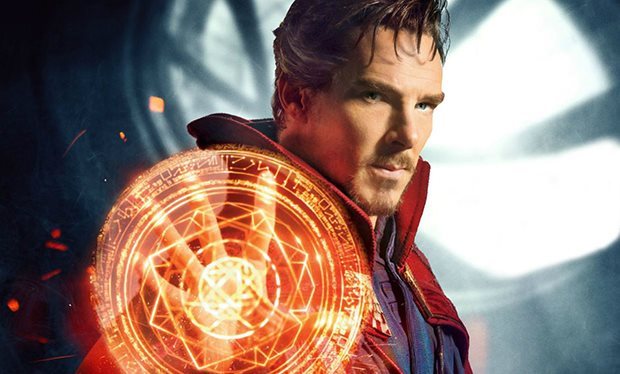chevron_left
-
play_arrow
NGradio So good... like you
share
close
Even by Marvel’s standards, Doctor Strange is a super-sized production.
Most of the film was shot at Longcross Studios in Surrey, where the crew painstakingly constructed 21 sets, including a Hong Kong street (complete with over 80 neon signs and a giant roof to keep the rain out) and Doctor Strange’s Sanctum Sanctorum, which took five artists 10 months to design.
However, director Scott Derrickson decided Kathmandu’s ancient temples couldn’t be faked. So last November, he and Benedict Cumberbatch jetted out to the capital of Nepal – and it didn’t disappoint.
“I’ve been all over the world, but there’s no place on the planet like Kathmandu,” says Derrickson. “It is a city with almost no Western influence in it. It is a large city that is so deeply mystical and religious in all operations, and in a most peaceful, beautiful, colourful way. The visual qualities of that city are unlike any place else.”

Sadhu (holy men) in the Pashupatinath Temple
The first scene was shot in Pashupati, home of Pashupatinath Temple, a famous Hindu temple on the banks of the Bagmati River in Kathmandu. There were 300 extras, made up of locals and tourists, along with cows and dogs. The production had an audience of curious locals, as well as the many families of wild monkeys that freely roam Nepal.
Cumberbatch was also smitten. “Kathmandu was absolutely vital to this film, I think not least because it’s so based in something that is exotic,” he explains. “It was a magical way to start the shoot. It’s important to a film like this – which has a profound gearshift into a spiritual and otherworldly dimension – that the portal for that be in a place that actually happens in itself – regardless of the Marvel cinematic universe – to be incredibly spiritual and marvellous.”
By the fourth day of shooting at Patan Durbar Square, they had a large crowd of Benedict Cumberbatch fans who had followed them there. Patan Durbar Square is a Unesco World Heritage Site that was badly damaged in the 2015 earthquakes. There was a crowd of hundreds shouting Cumberbatch’s name, who went wild when he waved from a building overlooking the square.

Patan Durbar Square is situated at the centre of the city of Lalitpur, one of the three Durbar Squares in the Kathmandu Valley
If Cumberbatch had hoped to escape his celebrity, he didn’t let his disappointment spoil the moment. “Being in Kathmandu with an entire film crew was astonishing, and kept on surprising me,” he says. “These beautiful places that you’d be lucky enough to get to as a traveller, let alone call it working, and then to watch that sunset over Boudhanath Stupa after a day of filming. That was perfection, really special, and tied the whole experience together for me. It was a brilliant footnote at the beginning of this long journey.”
Back in London, production created a Kathmandu street, loosely based on a real street in Nepal, which led into the Kamar-Taj courtyard. The set used real fruits, vegetables and meats, and for added authenticity, there were dogs and pigeons on set.
“The recreation of Kathmandu in London was so extraordinary,” Cumberbatch enthuses. “They recreated an actual street, and there were Nepalese extras here that had relatives who lived on that street. They were freaking out with the notion that if they went into that shop, they’d then be able to go upstairs to say hello to their cousin. We brought with us the smell of incense, maybe not quite the kind of full-on smell of being in a town like that, but even on that level, the odd flash of smoke or incense or food stuff, whatever it was that the set was being dressed with, was so evocative that you felt like you were back there. You could’ve just blinked and been back in Kathmandu.”

A real Kathmandu street, north of Durbar Square
The idea was that the shots of Benedict Cumberbatch actually on the streets of Kathmandu would blend seamlessly when he turns the corner and walks onto the Kamar-Taj set on the soundstage at Longcross.
“We did a few days filming in Kathmandu, filming Benedict in some of the temples, some of the streets, and he ends up going around the corner and it’s a set in London,” says production designer Charles Wood. “That’s very hard because Kathmandu is a most beautiful city and it’s steeped in history. To transition from that level of detail and history, with the shape of the streets, the warping of the buildings, these ancient bricks and these ancient tiles, was a real challenge. It was quite terrifying because if it didn’t work, it really didn’t work. But the art directors did a great job of putting that street set all together.”
But that was not the end if for Wood and his team. They then had to create the inside of the Kamar-Taj, where The Ancient One and her disciples reside. Wood had an army of sculptors creating beautiful columns and wall decorations and craftsmen building screens and doors to evoke the exotic feel of the ancient sanctuary.
Wood’s goal was to make an audience feel that The Ancient One really existed in this place. “And that it was truly spiritual, truly magical and was truly on top of a building that we photographed in Kathmandu that really existed there.”
Source: radiotimes.com
Written by: New Generation Radio
Rate it
Similar posts
ΔΗΜΟΦΙΛΗ ΑΡΘΡΑ
COPYRIGHT 2020. NGRADIO





















Post comments (0)